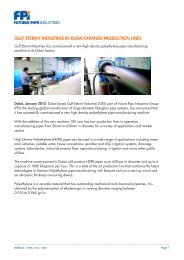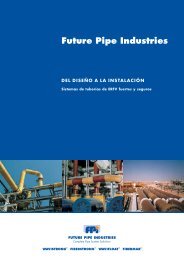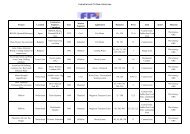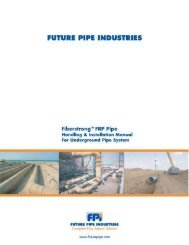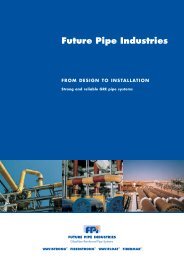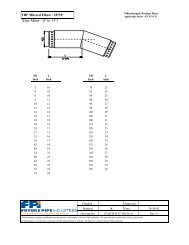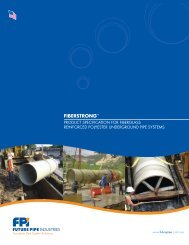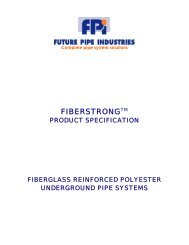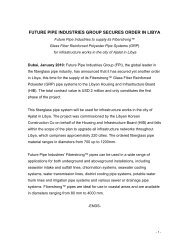Installation Manual - Future Pipe Industries
Installation Manual - Future Pipe Industries
Installation Manual - Future Pipe Industries
Create successful ePaper yourself
Turn your PDF publications into a flip-book with our unique Google optimized e-Paper software.
10.8. UV resistance<br />
The topcoat of Wavistrong pipes and fittings consists of a resin rich layer with a thickness of 0.3 mm. This layer offers<br />
sufficient protection against U.V. radiation. It is known that epoxy resin will be attacked in the long run due to weather<br />
exposure, which results in chalking of the topcoat. This chalky layer forms a protection against further attack of the topcoat.<br />
Should excessive chalking occur after several years of operation, a protective polyurethane paint coating can<br />
easily be applied.<br />
The painting procedure is as follows:<br />
- Clean the surface using thinner (e.g. Redox 0256)<br />
Apply one coat of epoxy undercoat (e.g. Redox EP 3200, rust brown or beige colour).<br />
The following layer can be applied after 8 hours’ drying time at 20°C or 4 hours at 40°C.<br />
Theoretic cover 5.5 m 2 /l at a thickness of 100 µm (micron).<br />
- Apply a top coat (e.g. Redox PUR 3355 polyurethane HB, white or other RAL colour).<br />
The following layer can be applied after 8 hours’ drying time at 20°C or 3 hours at 40°C.<br />
Theoretic cover 4.8 m 2 /l at a thickness of 100 µm (micron).<br />
If painting of a recently installed pipe is required, the surface of the pipe should be roughened in order to get<br />
a proper adhesion.<br />
10.9. Electrically conductive pipe<br />
When using electrically conductive R.T.R.P. pipe (series CS) the supports of the pipe fulfil two functions namely<br />
supporting and earthing of the pipe system. Static electricity originates e.g. by friction of transported media<br />
against the pipe wall. This is conducted away be anti-static (conductive) pipes. If the specially conductive adhesive<br />
Easy fit conductive is used, no interruption in conducting properties will occur. In the case of rubber seal joints or<br />
mechanical couplers, special measures have to be taken to ensure continuity of conductivity.<br />
Fig. 10.9.a.<br />
Saddles in which cables are inserted will be applied onto the pipe wall some 0.5 meter from the pipe spigot and<br />
bell ends. By these cables conduction of electricity over the joint will be ensured. Where the pipe is to be earthened<br />
by the pipe supports these have to be provided with a layer of electrically conductive rubber.In case of using a<br />
non-conductive mechanical coupler this coupler must be earthened.<br />
The conductivity is measured using a Megger with a reach of 0-2000 M Ohm, maximum 30 mA and a measuring<br />
accuracy of ± 10%.<br />
This method applies a potential difference of maximum 1500 Volt to the product to be tested and the subsequent<br />
resistance is measured. This test can also be used after the product has been exposed to a variety of chemical<br />
environments, in order to determine the possible effect on the electrical properties of the product.<br />
The resin outer layer may be removed to gain good contact with the conducting element.<br />
A conducting medium (salt water on the contacts, for example) is also allowed.<br />
The resistance measured must be at least 10 M Ohm. For more information, contact <strong>Future</strong> <strong>Pipe</strong> <strong>Industries</strong>.<br />
Wavistrong <strong>Installation</strong> <strong>Manual</strong><br />
55



